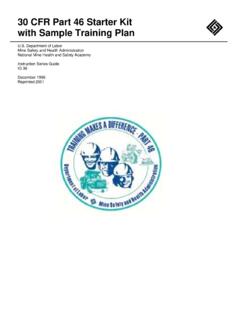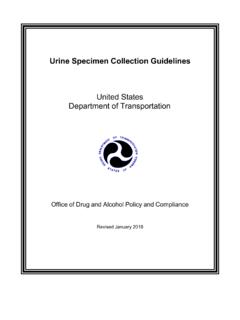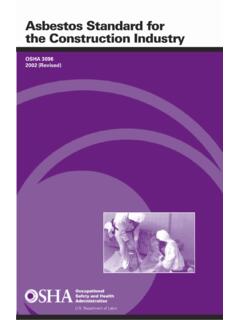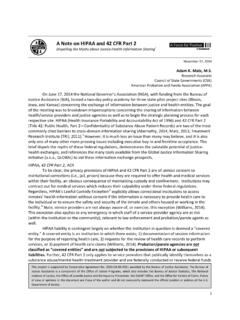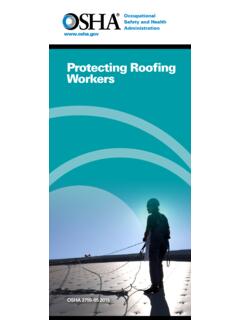Transcription of Commercial Pilot – Military Competence
1 FAA-S- ACS-12 Department of Transportation Federal Aviation Administration Commercial Pilot Military Competence Airman Certification Standards August 2018 Flight Standards Service Washington, DC 20591 i Acknowledgments The Department of Transportation, Federal Aviation Administration (FAA), Office of Safety Standards, Regulatory Support Division, Airman Testing Branch, Box 25082, Oklahoma City, OK 73125 developed this Airman Certification Standards (ACS) document with the assistance of the aviation community. The FAA gratefully acknowledges the valuable support from the many individuals and organizations who contributed their time and expertise to assist in this endeavor. Availability This ACS is available for download from Please send comments regarding this document using the following link to the Airman Testing Branch Mailbox.
2 Material in FAA-S-ACS-12 will be effective October 15, 2018. ii Foreword The Federal Aviation Administration (FAA) has published the Commercial Pilot Military Competence Airman Certification Standards (ACS) document to communicate the aeronautical knowledge standards for Military or former Military pilots seeking a Commercial Pilot certificate with the appropriate aircraft category and class rating per 14 cfr part 61, section The FAA views the ACS as the foundation of its transition to a more integrated and systematic approach to airman certification. The ACS is part of the Safety Management System (SMS) framework that the FAA uses to mitigate risks associated with airman certification training and testing. Specifically, the ACS, associated guidance, and test question components of the airman certification system are constructed around the four functional components of an SMS: Safety Policy that defines and describes aeronautical knowledge, flight proficiency, and risk management as integrated components of the airman certification system; Safety Risk Management processes through which both internal and external stakeholders identify changes in regulations, safety recommendations, or other factors.
3 These changes are then evaluated to determine whether they require modification of airman testing and training materials; Safety Assurance processes to ensure the prompt and appropriate incorporation of changes arising from new regulations and safety recommendations; and Safety Promotion in the form of ongoing engagement with both external stakeholders ( , the aviation training industry) and FAA policy divisions. The FAA has developed this ACS and its associated guidance in collaboration with a diverse group of aviation training experts. The goal is to drive a systematic approach to all components of the airman certification system, including knowledge test question development and conduct of the practical test. The FAA acknowledges and appreciates the many hours that these aviation experts have contributed toward this goal.
4 This level of collaboration, a hallmark of a robust safety culture, strengthens and enhances aviation safety at every level of the airman certification system. iii Revision History Document # Description Revision Date FAA-S-ACS-12 Commercial Pilot Military Competence Airman Certification Standards August 2018 iv Table of Contents Introduction .. 1 Airman Certification Standards Concept .. 1 Using the ACS .. 1 I. Commercial Pilot Privileges and Limitations .. 3 A. Pilot Qualifications and Responsibilities .. 3 B. Airworthiness Requirements .. 3 C. Medical Certification and Qualification .. 3 II. Air Traffic .. 4 A. National Airspace System .. 4 III. Accident Reporting .. 5 A. Accident Reporting .. 5 Appendix Table of Contents .. 6 1 Introduction Airman Certification Standards Concept The goal of the airman certification process is to ensure the applicant possesses the knowledge and ability to manage risk and demonstrate the skills consistent with the privileges of a Commercial Pilot Certificate and any associated ratings being exercised, in order to act as Pilot -in-command (PIC).
5 The Commercial Pilot Military Competence Airman Certification Standards identifies the areas of knowledge that the FAA has determined as necessary for a Military Pilot to receive a Commercial Pilot Certificate. The FAA has determined that only knowledge areas that are outlined in 14 cfr part 61, section will be tested. In fulfilling its responsibilities for the airman certification process, the Federal Aviation Administration (FAA) Flight Standards Service (AFS) plans, develops, and maintains materials related to airman certification testing. These materials include several components. The FAA knowledge test measures mastery of the aeronautical knowledge areas listed in Title 14 of the Code of Federal Regulations (14 CFR). Other materials, such as airman knowledge testing supplements in the FAA-CT-8080 series and an FAA online training course, provide guidance to applicants on aeronautical knowledge and risk management.
6 The FAA recognizes that safe operations in today's complex National Airspace System (NAS) require a systematic integration of aeronautical knowledge that an airman must possess. This ACS integrates the elements of knowledge in 14 CFR to Commercial Pilot standards, and any associated ratings that an applicant is entitled. In keeping with this integrated and systematic approach, the knowledge Task elements of each Task identify what the applicant must know and understand for the issuance of a Commercial Pilot Certificate under 14 cfr part 61. The applicant demonstrates this understanding by passing the knowledge test. Using the ACS The ACS consists of Areas of Operation arranged in a logical sequence, beginning with Commercial Pilot Privileges and Limitations and ending with Accident Reporting.
7 Each Area of Operation includes Tasks appropriate to that Area of Operation. Each Task begins with an Objective stating what the applicant should know. The ACS then lists the aeronautical knowledge elements relevant to the specific Task. The ACS uses Notes to emphasize special considerations. The ACS uses the terms "will" and "must" to convey directive (mandatory) information. The terms may and should denote items that are recommended but not required. The References for each Task indicate the source material for Task elements. For example, in Tasks such as Qualifications and Responsibilities to Act as a Commercial Pilot ( ), the applicant should be prepared for questions on any currency and recordkeeping presented in the References for that Task.
8 Each Task in the ACS is coded according to a scheme that includes four elements. For example, in the Task, Pilot Qualifications and Responsibilities ( ) the applicant should use the References for that Task and be prepared for questions on currency and recordkeeping. MC = Applicable ACS ( Military Competency) I = Area of Operation ( Commercial Pilot Privileges and Limitations) A = Task (Qualifications and Responsibilities to Act as a Commercial Pilot ) K1 = Task element Knowledge 1 (Currency and recordkeeping) Knowledge test questions are linked to the ACS codes, which will soon replace the system of Learning Statement Codes (LSC). After this transition occurs, the Airman Knowledge Test Report (AKTR) will list an ACS code that correlates to a specific Task element for a given Area of Operation and Task.
9 The LSCs translations may be found at Each LSC provides the applicant with information that will assist in future test taking. The current knowledge test management system does not have the capability to print ACS codes. Until a new test management system is in place, the LSC ( , PLT058 ) code will continue to be displayed on the AKTR. The LSC codes are linked to references leading to broad subject areas. By contrast, each ACS code is tied to a unique Task element in the ACS itself. Because of this fundamental difference, there is no one-to-one correlation between LSC codes and ACS codes. 2 For those applicants who do not pass the knowledge test, remedial instruction and an endorsement from an instructor is required for retesting. See Appendix 1 for details on passing the Military Competency Non-Category Specific (MCN) knowledge test.
10 The FAA encourages applicants to use this ACS when preparing for the knowledge test. In the case where an applicant has failed the knowledge test, the FAA encourages the applicant and his/her instructor to use this ACS when preparing to retest. 3 I. Commercial Pilot Privileges and Limitations Task A. Pilot Qualifications and Responsibilities References 14 CFR parts 61, 91, FAA-H-8083-3, FAA-H-8083-25 Objective To determine that the applicant exhibits satisfactory knowledge associated with operating as Pilot -in-command (PIC) as a Commercial Pilot . Knowledge The applicant demonstrates understanding of: Currency and recordkeeping. Documents required to exercise Commercial Pilot privileges, as per 14 cfr part 61. Passenger briefing requirements, to include operation and required use of safety restraint systems.










